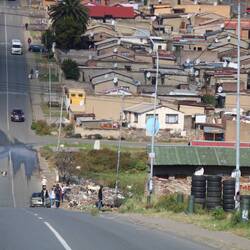Soweto tour
 May 9, 2023 in South Africa ⋅ ☀️ 15 °C
May 9, 2023 in South Africa ⋅ ☀️ 15 °C
I was really looking forward to our tour of Soweto. The place has been in my consciousness since I was a teenager and first became aware of the struggle against apartheid. I had an idea in my mind of what Soweto would be like. I was interested to see how the reality compared.
Our guide, DT, was from the Orlando East District of Soweto. On the way to the township, he told us about the city and his experience of growing up, living, and working there.
Soweto (South West Townships) was created in the 1930s when the white government started separating blacks from whites. Blacks were moved away from Johannesburg to an area separated from white suburbs by a so-called cordon sanitaire or sanitary corridor made up of undeveloped fields and wasteland. This was carried out using the infamous Urban Areas Act of 1923.
There was already a settlement on the site of present-day Soweto. It was a legacy of Johannesburg's gold-mining and brick manufacturing history when 100,000 people had descended on the area seeking their fortunes. A huge number of ramshackle homes had been built. The city developed randomly with no infrastructure and little organisation.
Over time, Soweto became the largest black city in South Africa, but until 1976, its population could only have status as temporary residents, serving as a workforce for Johannesburg. The city experienced civil unrest during the Apartheid regime. There were serious riots in 1976, sparked by a ruling that Afrikaans be used in African schools there. The riots were violently suppressed, with 176 striking students killed and more than 1,000 injured. Reforms followed, but riots flared up again in 1985 and continued until the first non-racial elections were held in April 1994.
Today, Soweto covers an area of over 200 square kilometres and is home to over 1.5 million people. The population is still predominantly black (98.5%), and the first language of the township is Zulu. The city has 200 schools and is beginning to break its reliance on Johannesburg as its main source of employment. Businesses are growing within the township.
Having said this, many of Soweto's residents are amongst the poorest in South Africa, earning on average a quarter of their compatriots living in Johannesburg. There are, however, many wealthier Sowetans, as shown in the number of larger, newly-built houses.
Soweto is mostly composed of old "matchbox" houses, four-room houses built by the government to provide cheap accommodation for black workers during apartheid. Many people who still live in matchbox houses have improved and expanded their homes, and the City Council has enabled the planting of more trees and the improving of parks and green spaces in the area.
Hostels are another prominent feature of Soweto. Originally built to house male migrant workers, many have been improved as dwellings for couples and families.
The result of all of this is that our first impressions of Soweto are that it is much more gentrified than we expected. Look below the surface, and you will see the poverty and catch sight of those who still live in makeshift accommodation. DT told us that these people are mostly illegals or drug addicts. He suggested that the problems Soweto has today are the same as any large city anywhere in the world. For him, it is home, and the strong sense of community he has with his neighbours means that he would never want to live anywhere else.Read more










